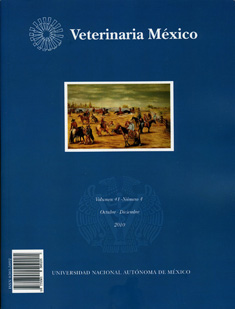Reproductive analysis of Iguana iguana females raised in captivity in Oaxaca, Mexico
Main Article Content
Abstract
With the objective to evaluate the reproductive stage in green iguana (Iguana iguana) females maintained in captivity in Oaxaca, Mexico, a total of 137 females were used during six years. Iguanas were fed with concentrate, frijolillo plants (Desmodium infortum) and tulip flower (Tulipa gesneriana). The females were identified and housed in cages of 30 m2 and were observed. Reproductive activities such as proestrus, estrus and pregnancy were daily recorded. In the stage of hatching, variables were measured in eggs that were incubated in styrofoam boxes with relative humidity of 65 to 85% and temperature between 28 to 34ºC, and the newborn were measured after hatching. Results were analyzed with descriptive statistics and canonical correlation analysis using the Statistical Analysis System. At the beginning of the reproductive season the females weighed 975.9 ± 405 g and measured 27.9 ± 3.4 cm snout-vent length, with a relative clutch mass of 36.3 ± 7.1%, clutch size of 23.5 eggs, hatching success of 64.8%, and newborn weight of 12.5 ± 2.3 g. The periods of proestrus, estrus, and pregnancy were 85, 36.2 y 59.7 days, respectively. The females weight at the beginning of the reproductive stage, snout-vent length and total were correlated (canonical correlation r = 0.69, r = 0.64 and r = 0.64, respectively) with the number and weight of newborn, indicating the importance of female management before the breeding season.
Article Details
License

Veterinaria México OA by Facultad de Medicina Veterinaria y Zootecnia - Universidad Nacional Autónoma de México is licensed under a Creative Commons Attribution 4.0 International Licence.
Based on a work at http://www.revistas.unam.mx
- All articles in Veterinaria México OA re published under the Creative Commons Attribution 4.0 Unported (CC-BY 4.0). With this license, authors retain copyright but allow any user to share, copy, distribute, transmit, adapt and make commercial use of the work, without needing to provide additional permission as long as appropriate attribution is made to the original author or source.
- By using this license, all Veterinaria México OAarticles meet or exceed all funder and institutional requirements for being considered Open Access.
- Authors cannot use copyrighted material within their article unless that material has also been made available under a similarly liberal license.



